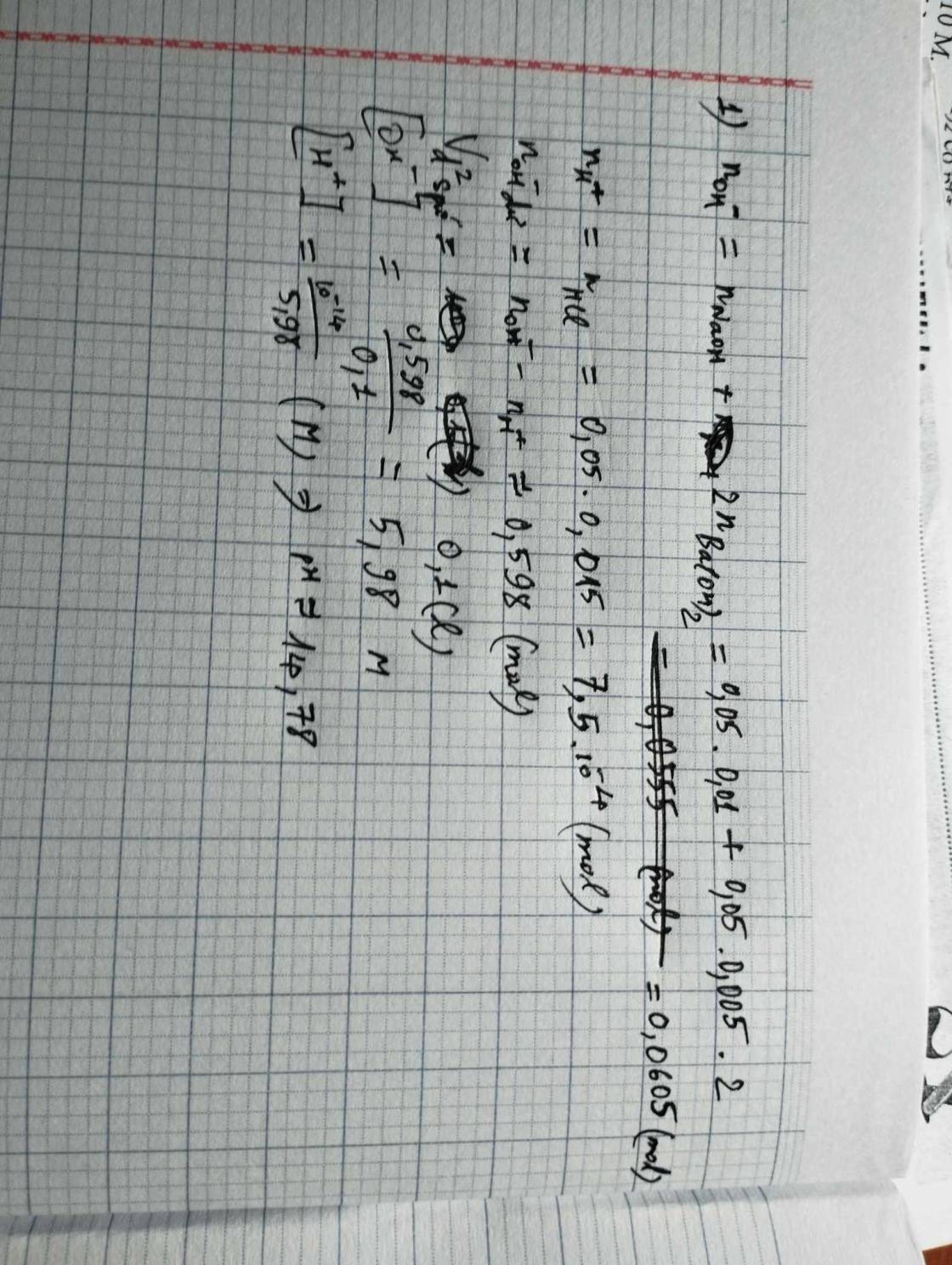Hãy nhập câu hỏi của bạn vào đây, nếu là tài khoản VIP, bạn sẽ được ưu tiên trả lời.

Vdd = 0.2 + 1.3 = 1.5 l
nOH- = CMdd * Vdd = 0.015 mol => n Ba(OH)2 = 0.0075 mol
=> CM (Ba(OH)2) = 0.0075/0.2 = 0.0375M
=> C

Đáp án C
nBa(OH)2 = 0,25 x mol; nOH-= 0,5x mol
nH+ = 0,025 mol, nSO4(2-) = 0,0025 mol
H++ OH- → H2O
0,025 0,025 mol
Dung dịch sau phản ứng có pH = 12 nên OH- dư
nOH- dư = 0,5x- 0,025
[OH-] dư = nOH- dư/ Vdd = (0,5x- 0,025)/0,5 =10-2 suy ra a = 0,06 M
Ba2++ SO42- → BaSO4
0,015 0,0025 0,0025 mol
mBaSO4 = 0,5825 gam

- Số mol NaOH=0,2a
-Số mol Ba(OH)2=0,2a
- Tổng số mol OH-=0,6a
\(\left[OH^-\right]=\dfrac{0,6a}{0,3}=2a\left(M\right)\)
pH=14+lg\(\left[OH^-\right]\)suy ra: 13=14+lg\(\left[OH^-\right]\)suy ra:
lg\(\left[OH^-\right]\)=-1 suy ra: \(\left[OH^-\right]\)=10-1=0,1M. Vậy:
2a=0,1 suy ra: a=0,05M
- Số mol OH-=0,6a=0,6.0.05=0,03mol
- Số mol H+=0,175.0,2.2=0,07mol
H++OH-\(\rightarrow\)H2O
- Số mol H+ dư= 0,07-0,03=0,04mol
- Tổng thể tích=100+200+200=500ml=0,5 lít
\(\left[H^+\right]=\dfrac{0,04}{0,5}=0,08\left(M\right)\)
pH=-lg\(\left[H^+\right]\)=-lg(0,08)\(\approx\)1,1

Gọi [Ba(OH)₂ ] ban đầu= a(a>0).
nOH⁻ = 0,2.a.2= 0,4a(mol).
pH=12→ pOH=14–12=2→[OH⁻] sau=10⁻² (M).
nOH⁻ =0,01. (1,3+ 0,2)= 0,015= 0,4a
↔ a= 0,00375(M).

Bài 1:
Ta có: \(\Sigma n_{OH^-}=n_{NaOH}+2n_{Ba\left(OH\right)_2}=0,05.0,01+0,05.0,005.2=0,001\left(mol\right)\)
\(n_{H^+}=n_{HCl}=0,05.0,015=0,00075\left(mol\right)\)
PT ion: \(OH^-+H^+\rightarrow H_2O\)
______0,001__0,00075 (mol)
⇒ OH- dư. nOH- (dư) = 2,5.10-4 (mol)
\(\Rightarrow\left[OH^-\right]=\frac{2,5.10^{-4}}{0,1}=2,5.10^{-3}M\Rightarrow\left[H^+\right]=4.10^{-12}M\)
\(\Rightarrow pH\approx11,4\)
Bài 2: Đáp án D
Giải:
Ta có: \(\Sigma n_{H^+}=n_{HCl}+2n_{H_2SO_4}=0,1.0,002+0,2.2.x=2.10^{-4}+0,4x\left(mol\right)\)
\(\Rightarrow\left[H^+\right]=\frac{2.10^{-4}+0,4x}{0,3}M\)
\(\Rightarrow pH=-log\left(\frac{2.10^{-4}+0,4x}{0,3}\right)=2,7\)
\(\Rightarrow x\approx9,964.10^{-4}\approx10^{-3}\)
Bạn tham khảo nhé!

Dd thu được có môi trường trung tính
`=>` Bazơ và axit đều hết
`n_{HCl} = 0,2.0,1 = 0,02(mol)`
`2HCl + Ba(OH)_2 -> BaCl_2 + 2H_2O`
`0,02 -> 0,01`
`-> V = V_{ddBa(OH)_2} = (0,01)/(0,1) = 0,1(l) = 100(ml)`
`Ba(OH)_2 -> 2OH^{-} + Ba^{2+}`
`0,1 -> 0,2`
`-> pH = 14 + log(0,2) ~~ 13,3`

\(n_{H^+}=0.3\cdot0.1\cdot2+0.3\cdot0.15=0.105\left(mol\right)\)
\(n_{OH^-}=0.001V\cdot0.3+0.001V\cdot2\cdot0.1=0.0032V\left(mol\right)\)
\(H^++OH^-\rightarrow H_2O\)
\(0.105.......0.105\)
\(n_{OH^-\left(dư\right)}=0.0032V-0.105\left(mol\right)\)
\(\left[OH^-\right]=\dfrac{0.0032V-0.105}{0.3+0.001V}\left(M\right)\)
\(pH=14+log\left[OH^-\right]=12\)
\(\Leftrightarrow log\left[OH^-\right]=-2\)
\(\Leftrightarrow log\left[\dfrac{0.0032V-0.105}{0.3+0.001V}\right]=-2\)
\(\Leftrightarrow V=33.85\left(ml\right)\)
nH+=0,3.0,1.2+0,3.0,15=0,105 mol
nOH- ban đầu =0,3V + 0,1.2V=0,5V mol
Sau phản ứng thu được dung dịch có pH=12
⇒OH- dư ⇒ pOH=2
⇒ [OH- ] dư = 0,01 M
nOH- dư = 0,01(0,3+V)=0,003+0,01V (mol)
nOH- phản ứng=nOH- ban đầu - nOH- dư
= 0,5V - 0,003 - 0,01V
= 0,49V - 0,003 (mol )
H+ + OH- → H2O
0,105 → 0,105
nOH- phản ứng = nH+
⇒0,49V - 0,003 =0,105
⇒ V≃0,22 lít=200ml

1)
Dung dịch có pH = 12 suy ra pOH = 2.
=> [OH−]=10−2M
=> CM Ba(OH)2=1/2[OH−] = 0,005M
2)
Dung dịch có pH = 13 suy ra pOH = 1.
=> [OH− ]=10−1 = 0,1M
=> nOH−=0,01.0,1 = 0,001M
Dung dịch sau pha loãng có pH = 12 suy ra pOH = 2.
=> [OH−] = 10−2 => Vdd = 0,001/10−2 = 0,1 lít
VH2O = 100 − 10 = 90 ml
3)
Dung dịch 1 có [H+] = 10 − 2 => nH+ = 0,3.10 − 2 = 3.10−3 mol
Dung dịch 2 có [H+] = 10 − 3 => nH+ = 0,2.10− 3 = 2.10−4 mol
Trộn 2 dung dịch được dung dịch có thể tích là
V = 300 + 200 = 500 ml = 0,5 lít
nH+ = 3.10 − 3 + 2.10 − 4 = 3,2.10 − 3 mol
[H+] = 3,2.10 − 3/0,5 = 6,4.10 − 3M
=> pH = −log[H+] = 2,194